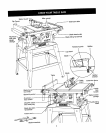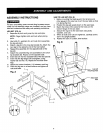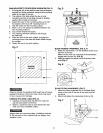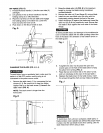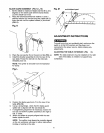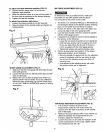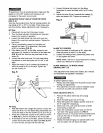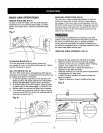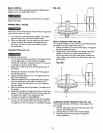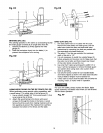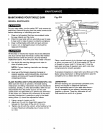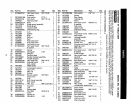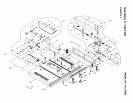
BASIC SAW OPERATIONS
RAISING THE BLADE (FIG. V)
To raise or lower the blade, turn the blade elevation
handwheel (1) to the desired blade height, and then
tighten lock handle (2) to maintain the desired blade
angle.
Fig. V
OVERLOAD PROTECTION (FIG. W)
This saw has a reset overload relay button (3) that will
restart the motor after it shuts off due to overloading or
low voltage. If the motor stops during operation, turn the
ON/OFF switch to the OFF position. Unplug the saw from
its power source. Wait about five minutes for the motor to
cool down. Push in on the reset button (3) and turn the
switch to the ON position.
To avoid injury, the ON/OFF switch should be in the OFF
position and the plug removed from the power source while
the motor cool down takes place, to prevent accidental
starting when the reset button is pushed. Overheating may
be caused by misaligned parts or dull blade. Inspect your saw
for proper setup before using it again.
USINGTHETABLE EXTENSION (FIG. X)
1 2
TILTING THE BLADE (FIG. V)
To tilt the saw blade for bevel cutting, loosen the
lock handle (2) and turn the tilting handwheel (3). Tighten
the lock handle (2) to secure.
ON / OFF SWITCH (FIG. W)
The ON / OFF switch has a removable key. With the key
removed from the switch, unauthorized and hazardous use
by children and others is minimized.
1. To turn the saw ON, insert key (1) into the slot in the
switch (2). Move the switch upward to the ON position.
2. To turn the saw OFF, move the switch downward.
3. To lock the switch in the OFF position,grasp the sides
(or yellowpart) of the switchtoggle (1), and pull itout.
4. Withthe switchkey removed,theswitchwillnot operate.
5. If the switchkey is removed while the saw is running,
itcan be turned OFF but cannot be restarted without
inserting the switch key (1).
Fig. W
I
2
1. Remove the stopscrews from the ends ofthe tubes.
2. Slide the ends of the tubes through both support
brackets on the side your workpiece will be needing
support, and replace the two stop screws.
3. Rotate the front tube to display the scale as an
extension of the table top scale.
4. Slide the extension out until the correct measurement
is displayed on the tube scale.
5. Loosen the fence handles, and raise or lower the
fence as needed.
6. Tighten all extension support handles and knobs.
Fig. X
16



